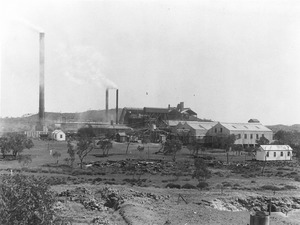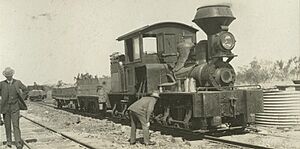Kuridala Township site facts for kids
Quick facts for kids Kuridala Township site |
|
|---|---|

Hampden Smelter at Kuridala, 2003
|
|
| Location | In the locality of Kuridala, Shire of Cloncurry, Queensland, Australia |
| Design period | 1900 - 1914 (early 20th century) |
| Built | 1880s-1920s |
| Official name: Kuridala Township, Hampden Smelter and Mining Complex, Hampden Township, Kuridala Smelter, Friezeland Township | |
| Type | archaeological (landscape) |
| Designated | 12 June 2009 |
| Reference no. | 645604 |
| Significant period | 1890s-1940s |
| Significant components | well, artefact field, tank stand, building foundations/ruins, bore, mullock heap, shaft, machinery/plant/equipment - mining/mineral processing, building foundations/ruins, pump, chimney/chimney stack, boiler room/boiler house, headframe, cemetery, grave marker, burial/grave, grave surrounds/railings, artefact field, engine/generator shed/room / power supply, building foundations/ruins, slag pile/slag heap, chimney/chimney stack, mounting block/stand, furnace, cutting - railway, embankment - railway, artefact field, building foundations/ruins, railway station, formation - railway |
| Lua error in Module:Location_map at line 420: attempt to index field 'wikibase' (a nil value). | |
The Kuridala Township site is a special place in Queensland, Australia. It is a heritage-listed former mining camp. People built it between the 1880s and the 1920s. It is also known by other names like Hampden Township and Hampden Smelter. This site was added to the Queensland Heritage Register on June 12, 2009.
Contents
A Brief History of Kuridala
Copper was first found at Kuridala in 1884. The Hampden mine started working in the 1890s. A group from Melbourne took over the mine in 1897. As the mine grew, the Hampden Cloncurry Limited company was formed in 1905–06.
The town was planned in 1910 and first called Hampden. Later, it was named Friezland. In 1916, its name officially became Kuridala. This change helped avoid confusion with another town. It also happened because German names were not popular during World War I.
The Hampden Smelter worked from 1911 to 1920. World War I was a very good time for the company. After the war, the mine and town became smaller. The Hampden Cloncurry company closed in 1928. People have continued to mine and explore the area from 1932 until today.
How Copper Mining Started
The Cloncurry copper fields were found by Ernest Henry in 1867. But it was hard to develop them at first. There was not enough money or ways to transport the copper. Also, copper prices were low.
Later, copper prices went up. New discoveries were made in the area. A railway was promised, and money came from Britain. This helped the mines grow. People from Melbourne also wanted to find another big mining success like Broken Hill. This made them very interested in the Hampden mines.
William McPhail and Robert Johnson found the copper at Kuridala in 1884. Fred Gibson owned the Hampden mine in the 1890s. In 1897, a Melbourne group bought it. They started the Hampden Copper Mines N. L. company. They began looking for more copper and testing samples.
In 1900, a government geologist said that most mines were not worth working. Only the Hampden Company's main mine seemed good.
Growth and the Railway
Copper prices rose again in 1905. In 1906, the government decided to extend the Great Northern railway. This railway would go from Townsville to Cloncurry. This helped the mines grow even more.
The Hampden Cloncurry Copper Mines Limited was formed in 1906. This new company bought the old company's mines. Many other companies were also investing in the Cloncurry area.
In 1908, Hampden Cloncurry and another company built a railway. This railway went from Cloncurry to Kuridala and Mount Elliott. The Hampden smelters started working in March 1911. They treated a lot of ore. In 1915, the Hampden Smelter made 813 long tons (826 t) of copper in one month. This was an Australian record at the time.
Life in Kuridala Town
The railway reached Kuridala by 1910. A health system was put in place in 1911 after a sickness outbreak. A hospital was built by 1913. It was known as the best hospital in the northwest.
At its busiest, the town had many businesses. There were six hotels, five stores, and four billiard halls. It also had three dance halls and a cinema. There were two ice factories and a soft drink factory. Chinese gardens grew along the creek. The town also had shops, four churches, a police station, and a school. The school had up to 280 students.
A big storm in December 1918 damaged the town. It also hurt parts of the smelter.
How the Smelter Worked
The Kuridala Hampden mines and smelters were very advanced. Ore from other mines came by a short railway line. Heavy ore from the Hampden mines was sorted. Then it was sent to large storage bins.
A central power plant provided electricity. It used gas engines and generators. These powered the machines in the works, shops, and mine pumps. They also provided electric light for the mine and town. The fuel for the gas plants was coal, coke, or charcoal.
The smelter had two large furnaces. It also had two electric converter vessels. Molten copper flowed into a special container. The waste material, called slag, was taken away on small railway tracks. The copper was then sent to be cleaned and shipped out. It was made into large blocks of blister copper.
Decline of the Town
World War I brought four years of good times for the Cloncurry area. The Hampden Cloncurry Company made a lot of money. They built small railways to their mines. This helped them get ore regularly and save on transport costs. In 1917, they added a plant to treat the ore better.
But in 1918, the British government stopped controlling copper prices. This caused problems for the company. They lost a lot of money. In 1920, they had to stop all operations. This happened after a bank stopped giving them money for copper waiting to be shipped.
The company tried to get help from the government. But the government was not very helpful. In 1926, Hampden Cloncurry sold its assets. Another company, Mount Elliott, bought almost everything. The company was officially closed in 1928.
The town's size changed with the company's success. In 1913, there were 1,500 people. By 1920, there were 2,000. But by 1924, only 800 people remained. Many buildings, like the hospital and hotels, moved to Mount Isa.
Over nine years, Hampden Cloncurry was one of Australia's biggest mining companies. It produced 50,800 long tons (51,600 t) of copper. It also made gold and silver. The company also helped create Metal Manufacturers Limited. This company became one of Australia's largest manufacturers.
In 1942, Mount Isa Mines bought the Kuridala Smelters. They used parts to build a copper furnace. This furnace started working in April 1943 to help with wartime needs. The Tunny family continued to live and mine at Kuridala from 1932 to 1969. A post office stayed open until 1975. The last person living there moved away around 1982.
Since 1948, many companies have explored the Kuridala area. They continue to test the ore there.
What Remains Today
Town Area Remains
The old town site still has foundations and other signs of buildings. These include homes and shops. The area is about 1.5 kilometres (0.93 mi) long and 1.2 kilometres (0.75 mi) wide. You can still see where the bakery, hotel, and butcher's shop were. The hospital site is on a small hill. It has a large water tank base and an old oven. Many old items like glass bottles and metal tins are found here.
The Cemetery
The cemetery is at the southern end of the site. It was re-fenced in 1988–89. There are over 360 graves that can be seen. Many graves have headstones, with 40 of them marked. These date from 1909 to 1920. Some graves have railings. Many are marked by old cast iron beds. Smaller beds show children's graves. Some crosses were made from kerosene tins.
Railway Station and Line
The railway station site is just north of the cemetery. You can see a cement surface and other foundations. Wooden railway sleepers are still in place along parts of the railway formation. Old embankments and cuttings show where the railway line ran. Many old items from the station and line are still there.
Other Sites and the Smelter
You can find other old settlement sites around the area. These include pieces of glass bottles, pottery, and metal items.
The smelter remains include a blast furnace and an iron chimney. A very large pile of slag (waste from smelting) stretches north from the smelter. Next to the furnace are another iron chimney and foundations of the powerhouse. The steel chimneys and parts of the smelter are very rusty. Their foundations are cracking.
Mine Areas
You can still see foundations and parts of four old mines. The Hampden No. 2 mine has an old boiler and pump. Logs remain at the old sawmill site. The Hampden No. 1 mine has the largest group of foundations. These include crusher and winch mounts.
At the Hampden No. 3 shaft, you can see a headframe and a winder house. There are also waste piles and a boiler on a brick base. These bricks were made from slag. This shows a clever way of recycling. The Hampden Consol mine has an iron chimney from 1913. It also has engine house remains and waste piles. Other old mine shafts and tunnels likely remain underground. These could tell us about old mining methods.
Why Kuridala is Important
The Kuridala Township, Hampden Smelter, and Mining Complex is important for understanding Queensland's history. It helps us learn about old copper mining and how towns grew in North Queensland. It was one of the first big copper mining sites near Cloncurry.
The site has many archaeological remains from mining. The old smelter works are very complete for North Queensland. The Hampden Smelter has a rare, old water-jacket blast furnace. This is the only one of its kind left in Queensland. The large slag pile is also very impressive. Studying the smelter can help us understand early copper processing.
Studying the town area can tell us about the community. We can learn how it started, grew, and declined. Looking at old items can give clues about people's daily lives. It can also show how isolated mining communities lived.
The cemetery is one of the largest linked to mining in North Queensland. It can give more information about the community. Studying the graves and markers can reveal details about people's backgrounds. It can also show how healthy people were in the town.
Because the community was so isolated, studying the site can show differences. It can reveal what was planned versus what actually happened. For example, old maps show neat streets. But archaeological evidence shows homes spread out in other areas.
The Kuridala complex also helps us compare it to other copper mining sites. These include Mount Cuthbert and Mount Elliott. Studying Kuridala can also help answer questions about workers, social classes, and how businesses operated.



